One year ago, state media largely ignored the biggest outbreak of civil unrest in Kazakhstan’s history. The job of informing the public objectively about the widespread protests fell on independent reporters and a few so-called citizen journalists and bloggers who did their jobs at great personal risk. These journalists were attacked by protesters, assailed and tear-gassed by police, shot with rubber bullets, detained, and in some cases arrested, beaten, and imprisoned.
When the air, so recently filled with smoke from grenades and bullets, both rubber and real, cleared, reporters were the ones pressing the government for a full accounting of the 238 people killed, more than 4,500 injured, around 10,000 detained, and several hundred reportedly tortured.
This is the story of the Qandy Qantar — “Bloody January” — uprising through the eyes of those who covered it, beginning in Zhanaozen and ending in Almaty.
You can read this series in English at The Diplomat and in Russian and Kazakh at Orda.kz.
URALSK, Kazakhstan: Journalists Lukpan Akhmedyarov and Raul Uporov spent January 3 driving around town, looking for protesters. They were sure Uralsk would follow other Kazakh cities that had erupted in protest following Zhanaozen’s demonstrations against higher gas prices.
At 10:30 p.m., as Lukpan was getting ready for bed, he received a video showing a crowd of men shouting on the central square as police officers encircled them. Lukpan immediately drove to the center of town.
“These people were not the typical protesters,” he said. “Most of them were truck drivers. You could see their trucks parked near the square.”
Lukpan, 47, is an expert on protests. He has been detained countless times at protests and jailed for covering them. He’s also been shot, stabbed, and sued. Previously he worked for Uralsk Weekly, a scrappy independent print and online newspaper. Now, he and Uporov, a former Uralsk Weekly photographer, report news and make documentary films on their YouTube channel, Просто Журналистика — Just Journalism.
Lukpan thought the police, dressed in black clothes and wearing bulletproof vests, wouldn’t allow him into the square. But they moved aside to let him in.
For two hours, Lukpan livestreamed the small demonstration supporting the Zhanaozen protests. Around 1 a.m., the crowd dispersed and agreed to gather again the next day.
“Bring everyone you know,” they told each other.
Uralsk — or Oral in Kazakh — is a northern city of 236,000, just 18 miles from the Russian border. One of the country’s oldest cities, Uralsk dates to 1584 and was the site of a failed Cossack revolt against Russia.
The next morning protesters met at a supermarket on the edge of town and grew in number as they peacefully marched to the central square. Many held Kazakh flags and sang the national anthem. Several told Lukpan, “This is the first time we are finally all together.”
By the time the protesters reached the square, there were at least 2,000 people, Lukpan said. They built a platform about five feet high out of snow. The mayor appeared and said he wanted to hear their demands.
“It was no longer about gas prices,” Lukpan remembered. “They wanted to upset the whole system. They wanted parliamentary elections. They wanted to change the laws so that people could have protests without requiring the government’s approval.”
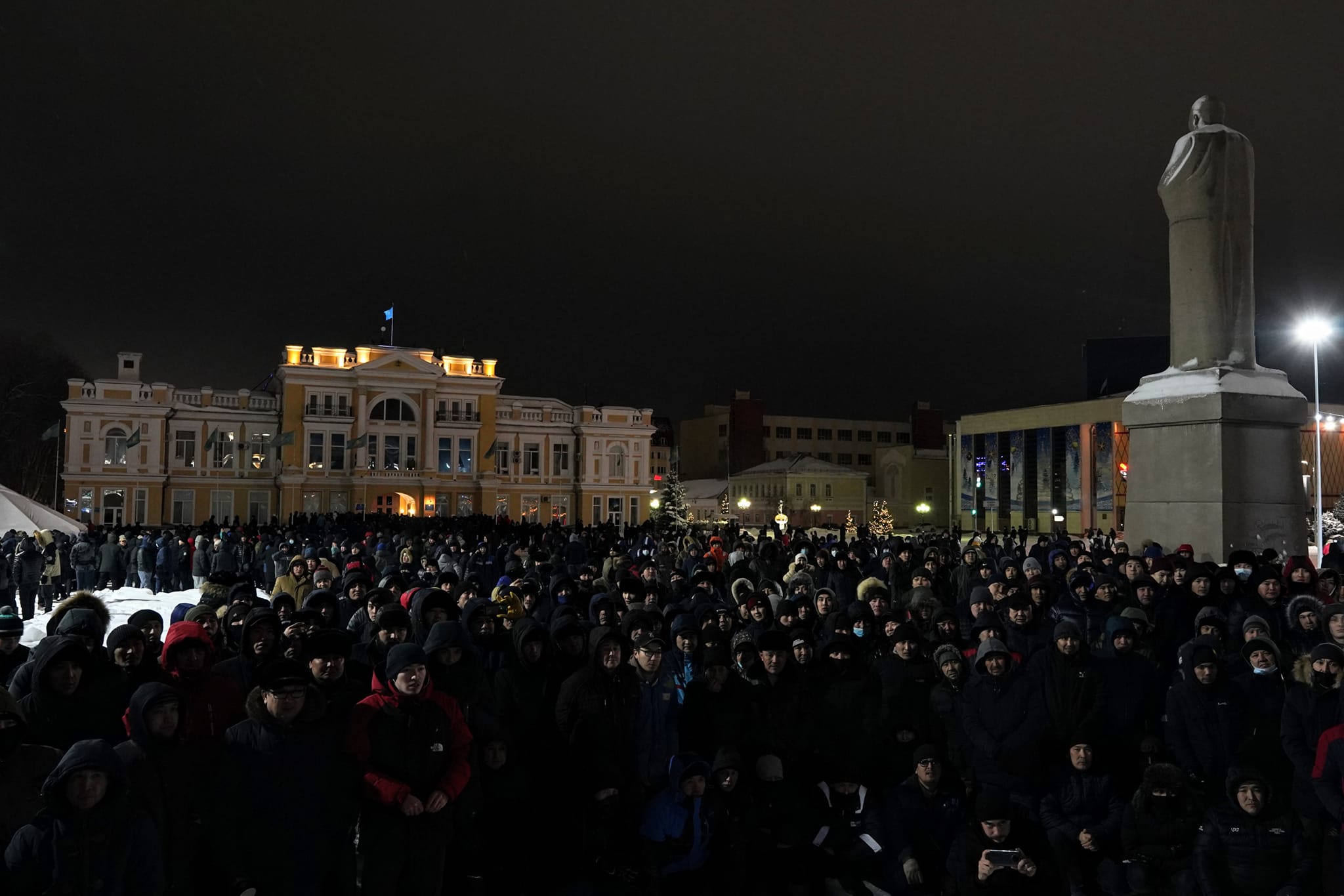
Crowds amassed in Uralsk’s central square. Photo credit: Raul Uporov
A Peaceful Rally Begins in Kyzylorda
Meanwhile, 950 miles away in the city of Kyzylorda, on the southern end of Kazakhstan, people were gathering outside the Aray City Mall at a place where taxi drivers usually loitered. That morning, police had detained about 20 young people outside the mall, and demonstrators were demanding their release.
Zhamilya Kassymkanova, 31, an Instagram blogger, arrived at the mall around 1:30 p.m. and began filming. She had no idea that the photos and videos shot over the next three days would document the biggest unrest in the region. Yerkanat Sarsenbay, 34, a state journalist who’d just left his job in December, was also filming and taking notes.
Although it’s the capital of the Kyzylorda region, the city of Kyzylorda — population 242,000 — doesn’t have any independent media outlets. Located about 80 miles from the southern border with Uzbekistan, Kyzylorda is generally considered a sleepy steppe town. But its role in the January protest was about to garner the city enormous attention.
By 5 p.m., Zhamilya was shooting photos of a crowd outside the mall that had grown so large people were spilling onto Nazarbayev Avenue. The crowd then divided, with one part moving to the center square outside the regional court and the other staying at the mall. Drunken “provocateurs” tried to set fire to a large holiday tree outside the mall, she said, and then tried to attack the police. Other protesters stopped them. The police watched but didn’t detain anyone.
At 8:30 p.m. the regional mayor tried to talk to the crowd. But people shouted over her. One man read a list of demands. Protesters complained of falling living standards, rising grocery and gasoline prices, and the poor condition of roads. When the mayor left, protesters attacked her car.
As the night wore on, more people showed up with their families and children. The protest had the feel of a lively block party, Zhamilya said. People passed out tea and food. One woman made plov. Protesters took turns reading poems at the microphone. The crowd sang the national anthem.
Batyrkhan Zhumabaev, 42, a railway worker, called his brother and told him it had been a “peaceful march.”
No one was prepared for how radically different the next day would be.

Crowds gathered in Kyzylorda, too. Photo credit: Anonymous.
Provocateurs Arrive in Uralsk
Around 8 p.m., back in Uralsk, Lukpan noticed a scuffle in front of the mayor’s office. When he got closer, he saw about 20 young men wearing khaki canvas overalls and medical masks. They were kicking at another man and shouting: “Let’s get into the mayor’s office!”
A friend asked Lukpan to “talk some sense into these men.” Two people lifted him above the crowd. Someone gave him a bullhorn. Lukpan shouted at the men in Kazakh and Russian, saying “What are you doing? It’s a shame! Don’t do that! There’s no point. It’s important for us to maintain our dignity.” He told the men there was no valuable property in the mayor’s office and asked them to join the main crowd.
Lukpan acknowledged he felt conflicted about his role. “I was a journalist there, and then in the next minute I was part of the movement.”
Maria Melnikova, a freelance reporter at Azattyq, wasn’t surprised Lukpan, her friend and former colleague at Uralsk Weekly, spoke up.
“Lukpan is doing journalism a different way,” she said. “He’s always had something inside of him to protest, to rebel. Sometimes he’s even aggressive and very emotional.”
Two provocateurs who reeked of alcohol pushed Lukpan. One grabbed his chest. Lukpan and his friends decided to return to the main square.
At around 11 p.m., loudspeakers placed near the windows of the mayor’s office began to play a recorded message: “Your actions are illegal, and you must go.” After the message, a siren sounded for 30 seconds and then everything repeated on a loop.
Despite the loud noise, several journalists remained, including Lukpan, Raul, and Maria. Like Lukpan, Raul and Maria have been detained several times for attempting to cover protests. Raul, 41, a witty man who is ethnically Russian and Tartar, has successfully used humor to reduce tension with police.
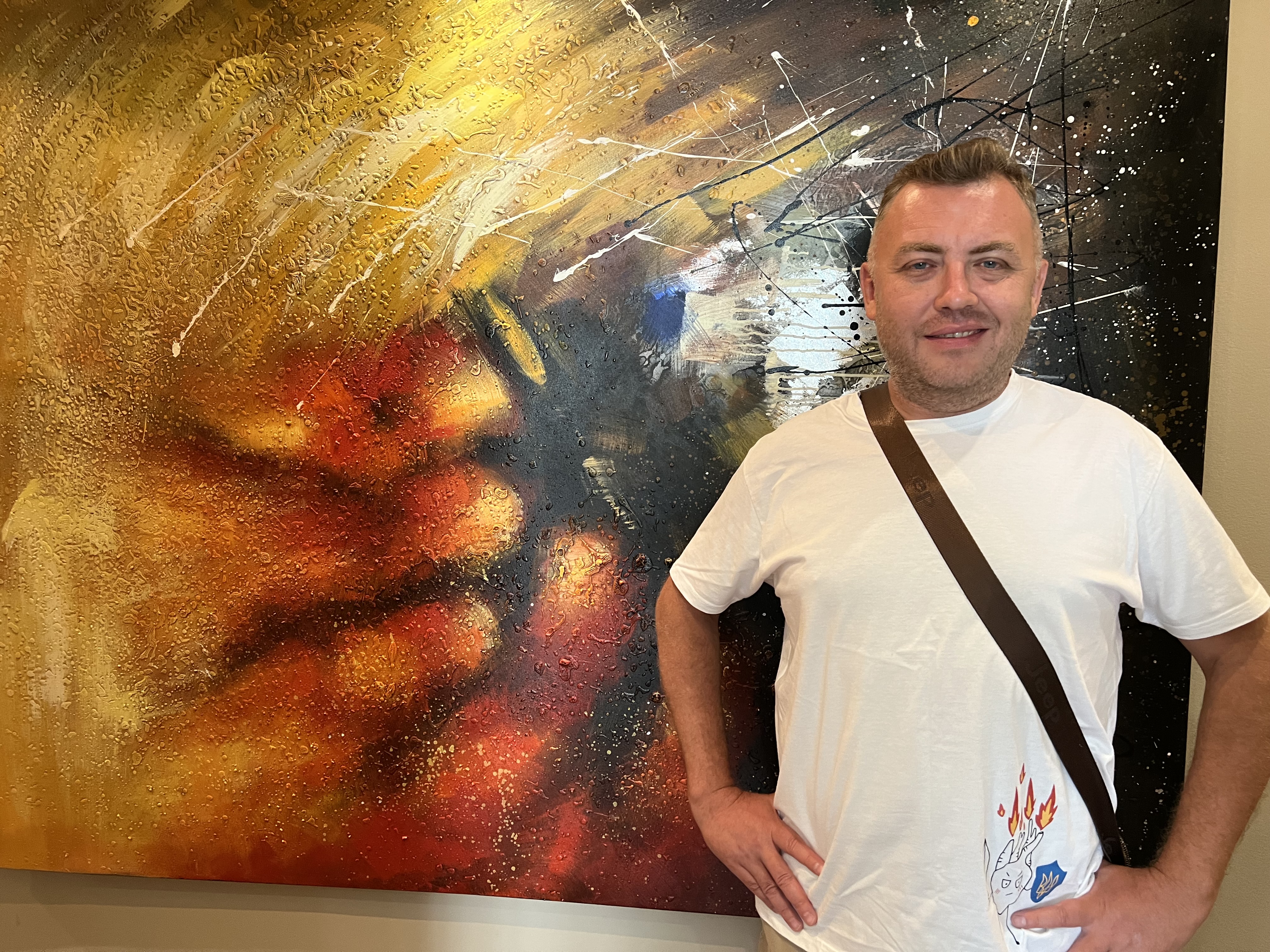
Raul Uporov documented the events of early January in Uralsk with his camera. Photo provided by author.
Maria, 36, a single mother of a 14-year-old boy and 9-year-old girl, hasn’t been so lucky. In March 2020 during the pandemic, she reposted a silly photo about a Kazakh monument. The police showed up at her house and started a criminal investigation against her for “spreading false information during an emergency order.” The case, which carries a 10-year sentence if convicted, remains open and weighs on Maria. Complicating her situation is that the government refuses to give Maria journalist credentials, forcing her to work unofficially and without a byline.
“It’s like I’m a ghost,” she said.
Shock Grenades
By 3 a.m. on January 5, the crowd had thinned considerably. Uralsk Weekly reporter Talgat Umarov, 35, and cameraman, Erkebulan Gapuov, 29, were the only journalists left on the square when police lined up in a row wearing balaclavas and riot shields. Thirty minutes later, they heard loud explosions and saw smoke.
Talgat immediately thought of the documentary footage from the 2011 Zhanaozen Massacre — something he’d viewed two weeks earlier when Lukpan and Raul released their documentary about the massacre on its 10th anniversary, December 16, 2021. The footage shows police shooting at people who are running away. Talgat knew he had to capture on video what was unfolding on the square.
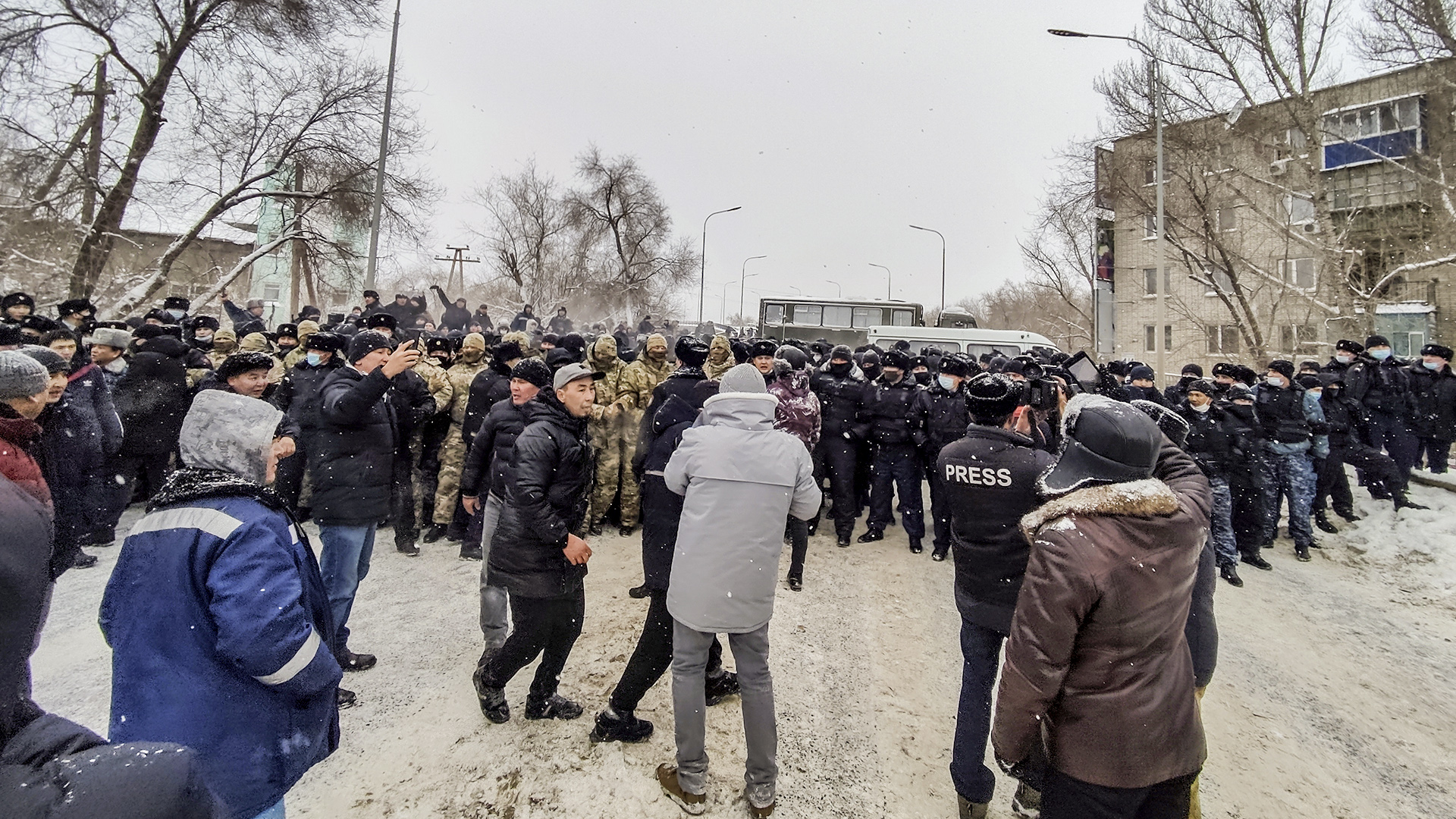
Police and security forces face off with protesters in Uralsk. Photo credit: Talgat Umarov and Yerkebulan Gapuov (Uralsk Weekly uralskweek.kz)
“When I found myself in a situation where grenades were exploding around me and a convoy of policemen were coming at me, I was scared. I was sure that if our policemen were given the order to shoot, they will shoot,” Talgat said.
Talgat and Erkebulan filmed the scene, then rushed to the Uralsk Weekly offices and called Lukpan, who had just gone to bed.
Lukpan remembers the urgency in his friend’s voice. “He said a lot of people are hurt. The police beat up on people and arrested them,” Lukpan said. “There’s a gunfight here. Everyone’s running.”
Lukpan urged Talgat to post the video immediately, because they didn’t know how long before the internet would be shut off. The video shows men milling around the square. Then there is a succession of loud booms. Men are yelling and running. A line of police with shields begins to march toward the protesters. More grenades go off and a cloud of smoke descends on the square as men scream and run between pine trees decorated with colored lights and laden with snow.
Smoke, Grenades, and Bullets
A few hours later at 8 a.m. in Kyzylorda, police detained about 20 protesters who had stayed all night and were blocking Nazarbayev Avenue, a busy thoroughfare, Zhamilya said.
She arrived around 1 p.m. and began filming protesters gathering on Nazarbayev Avenue. When the police tried to remove them, the protesters and police clashed, she said. As police advanced toward protesters, the crowd began throwing stones at the police. Police retaliated with tear gas, shock grenades, and rubber bullets. Some protesters set cars on fire. Others hurled gas onto police officers. Police fled.
Zhamilya filmed police buses burning and billowing black smoke coming from several government buildings. She watched as protesters stole cars parked in a government garage, then set the garage on fire. She saw people looting the press service building, carrying out camera equipment.
Yerkanat, the former state media journalist, lives near the mall, and ran to the scene. He saw a man waving a Kazakhstan flag call out to people to follow him to the mayor’s office. The crowd marched behind him and chanted “Shal, ket!” — “Old man out!” — referring to President Nursultan Nazarbayev, who has continued to have an iron grip on the country’s government despite his March 2019 resignation.
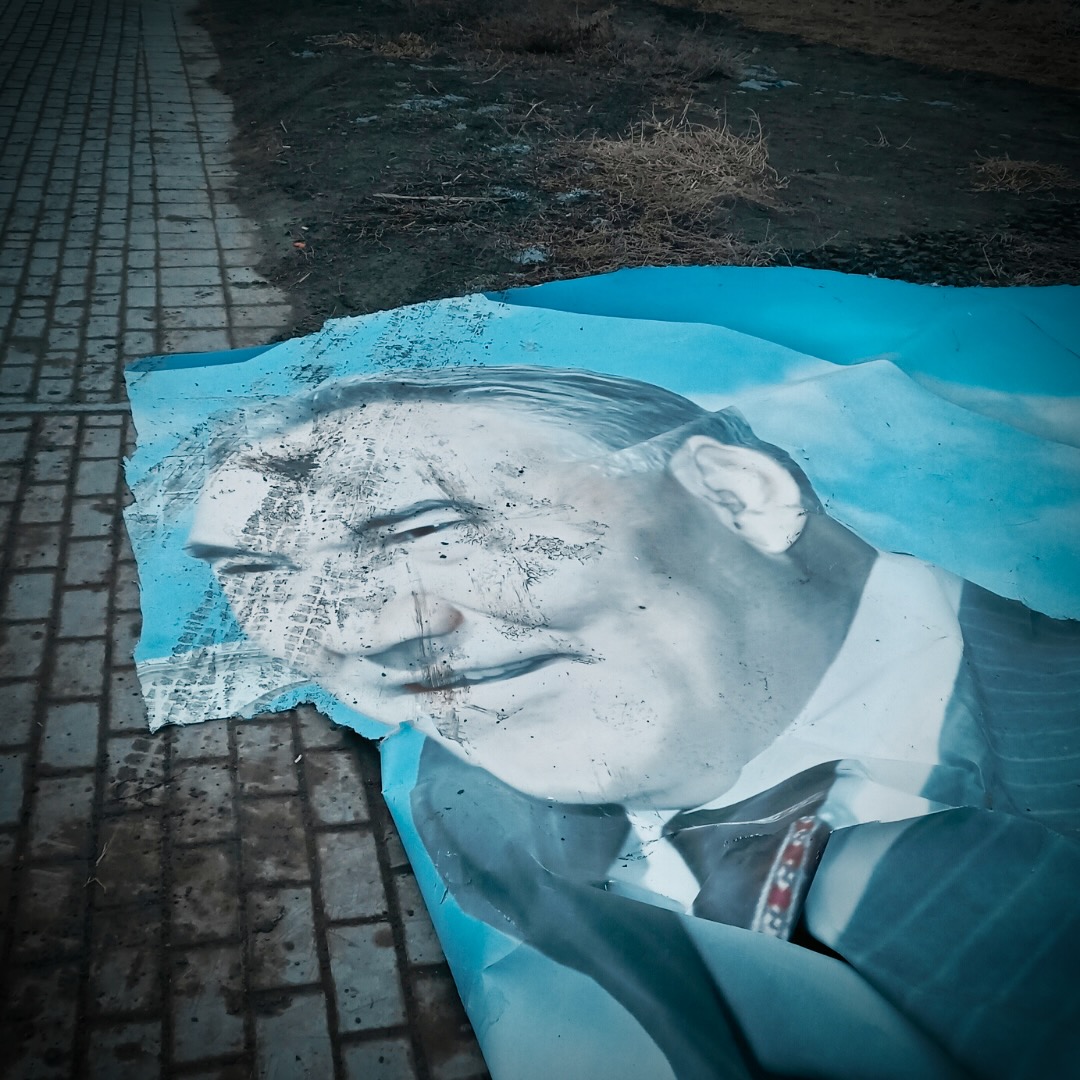
Poster with Nursultan Nazarbayev’s face laying on the ground in Kyzylorda. Photo credit: Zhamilya Kassymkanova
Yerkanat was filming on his phone when someone asked him to stop. “They didn’t want to be held accountable later,” he said. Zhamilya also had several protesters curse her and demand she stop filming.
When the crowd of several thousand reached the mayor’s building, they were met by special forces soldiers, who wore helmets and carried shields and rubber batons. Yerkanat saw protesters surround a cameraman from Khabar TV, a state channel based out of Astana, and demand he hand over recordings or they would break his camera. Then they forced him to give them both the main and the backup flash cards, Yerkanat said. Protesters rushed the gates to the mayor’s building. That’s when police threw grenades and began firing into the crowd.
Farhat Omarov, 29, was shot in the heart and the leg. His mother would find him in the morgue two days later with “unknown man” written on his leg.
Young protesters broke windows. Then the special forces retreated, Yerkanat said.
A group of people urged the demonstrators to storm the police station. Drivers of a truck and car rammed the gates protecting the police station but couldn’t get through the barriers. Several cars in the police parking lot were set on fire. Police fired shots around the station.
Nursultan Bekbolatov, 28, was driving home from a funeral dinner with his family when he and three other family members in his car were shot. The victims were rushed to the hospital by another passing car. Bekbolatov died; the other members of his family survived.
About the same time, Zhumabaev — the railway worker who’d bragged about the peaceful rally he’d attended the previous day — arrived at the hospital from a gunshot wound. He died two days later.
After watching protesters make several unsuccessful attempts to take over the police building, Yerkanat decided it was too dangerous and returned home.
Zhamilya was also filming outside the police department, her hands trembling as she got close to the crowd standing before a fire at the entrance. Activists and protesters were attempting to free those whom police had detained, she said. Protesters threw stones at the streetlights and security cameras to prevent their actions from being video recorded.
“I didn’t see anyone that I knew in the chaos,” Zhamilya said. “They didn’t seem like local people.”
Like Yerkanat, she thought it wasn’t safe and went home to care for her 9-year-old son and her mother. But even when she reached her house near the main police station, she could still hear gunfire. She locked her doors and windows. She and her mother put knives under their pillows.
“We were now responsible for our safety,” she said. “We didn’t see any police left in the city.”
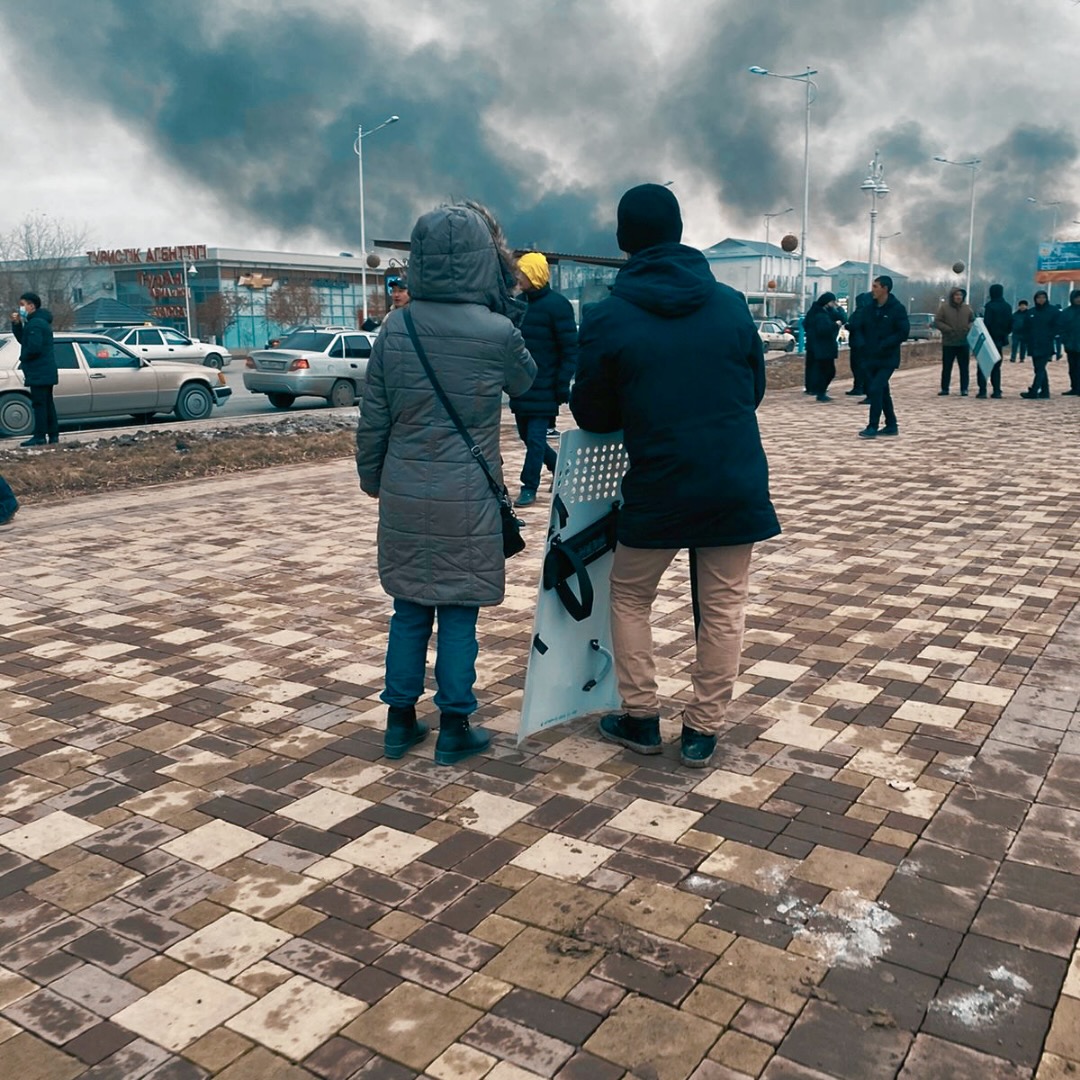
Smoke rises in the distance as protesters watch in Kyzylorda in early January 2022. Photo credit: Yerbolat Tursynkozh
Detention and Interrogations
On January 5 at 11:30 a.m., Serik Yessenov, a 26-year-old reporter at Uralsk Weekly, was sent to Abay Square. He found the place mostly empty and blocked off by military-looking police wearing fatigues, balaclavas, and bullet proof vests. Barbed wire was stretched around the perimeter and armored cars were parked in front of the regional mayor’s office. Police were detaining anyone in the area, even two men who were just driving by.
Two policemen approached Serik, who was filming the scene and wearing a yellow press armband, and attempted to take away his camera. Serik repeatedly shouted that he was a journalist. The police twisted his hands behind his back and dragged him to an armored paddy wagon. Inside two riot policemen wearing balaclavas pushed him into a seat.
“One of the masked guys looked as if he were some kind of criminal. He had such anger in his eyes,” Serik remembered. “Even if I wanted to do something, like try and resist, that guy was ready to use force.”
Serik had managed to hide his cellphone in his jeans pocket. He quietly made a call to his editor, Tamara Eslyamova, who told him to stay calm and cooperate.
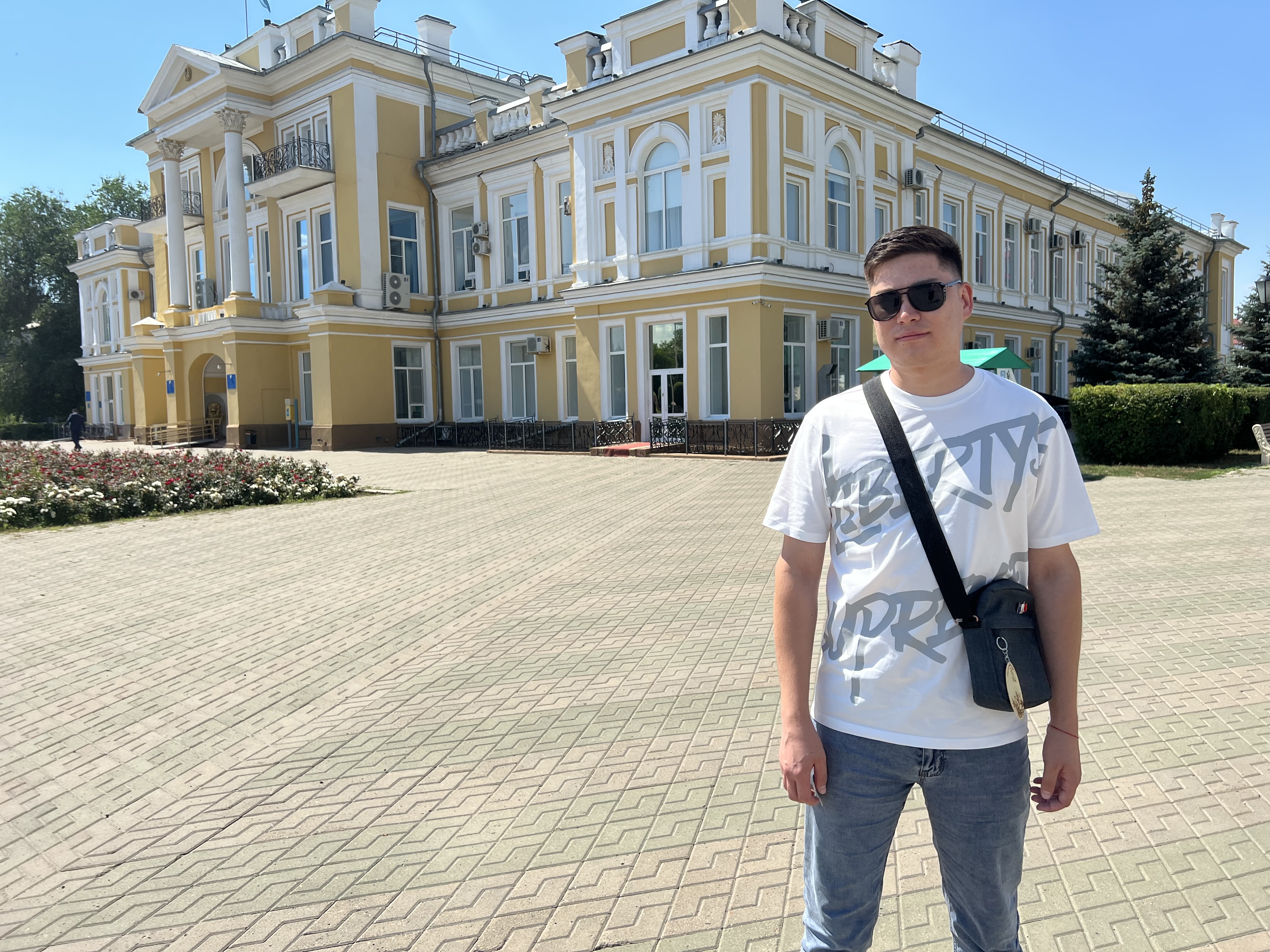
Serik Yessenov, a 26-year-old reporter at Uralsk Weekly, was sent to Abay Square on January 5, 2022, to report on the protests. Photo provided by author.
Once at the station, police seized his phone. As he was escorted inside, he saw one of his former colleagues, Yessenzhol Yelekenov, being interrogated. Serik thought he didn’t look so good. Police took Serik’s fingerprints and his mugshot. He was listed as No. 463 in the log of those who were interrogated.
A man in civilian clothes interrupted Serik’s interrogation and had him released. Later Serik learned that Tamara had called the police station and insisted he be released.
Yessenzhol, though, remained in police custody.
He’d arrived at the square about two hours before Serik. Masked officers threw him into a paddy wagon and beat his legs and hips with wooden batons on the way to the station, he said.
Yessenzhol, 32, is a slight man, barely 5 feet, 2 inches tall, and weighs 108 pounds.
At the police station, a State Security (KNB) officer refused to believe he’d been beaten. Instead, the officer told Yessenzhol that the KNB knew all about him — that he used to work at Uralsk Weekly and that now he had a new website.
“Don’t you want to work with us?” the KNB officer asked. “We can order you to write a post on the website.”
Yessenzhol replied, “You know that I’m a journalist. I will never work with policemen.”
The KNB officer threatened to put Yessenzhol in prison if he showed up again on the square. The officer returned his phone, but all his footage of the protest was deleted, he said.
That same morning, Lukpan was looking for protesters when police stopped him in his car and took him to the police station, where they questioned him for five hours.
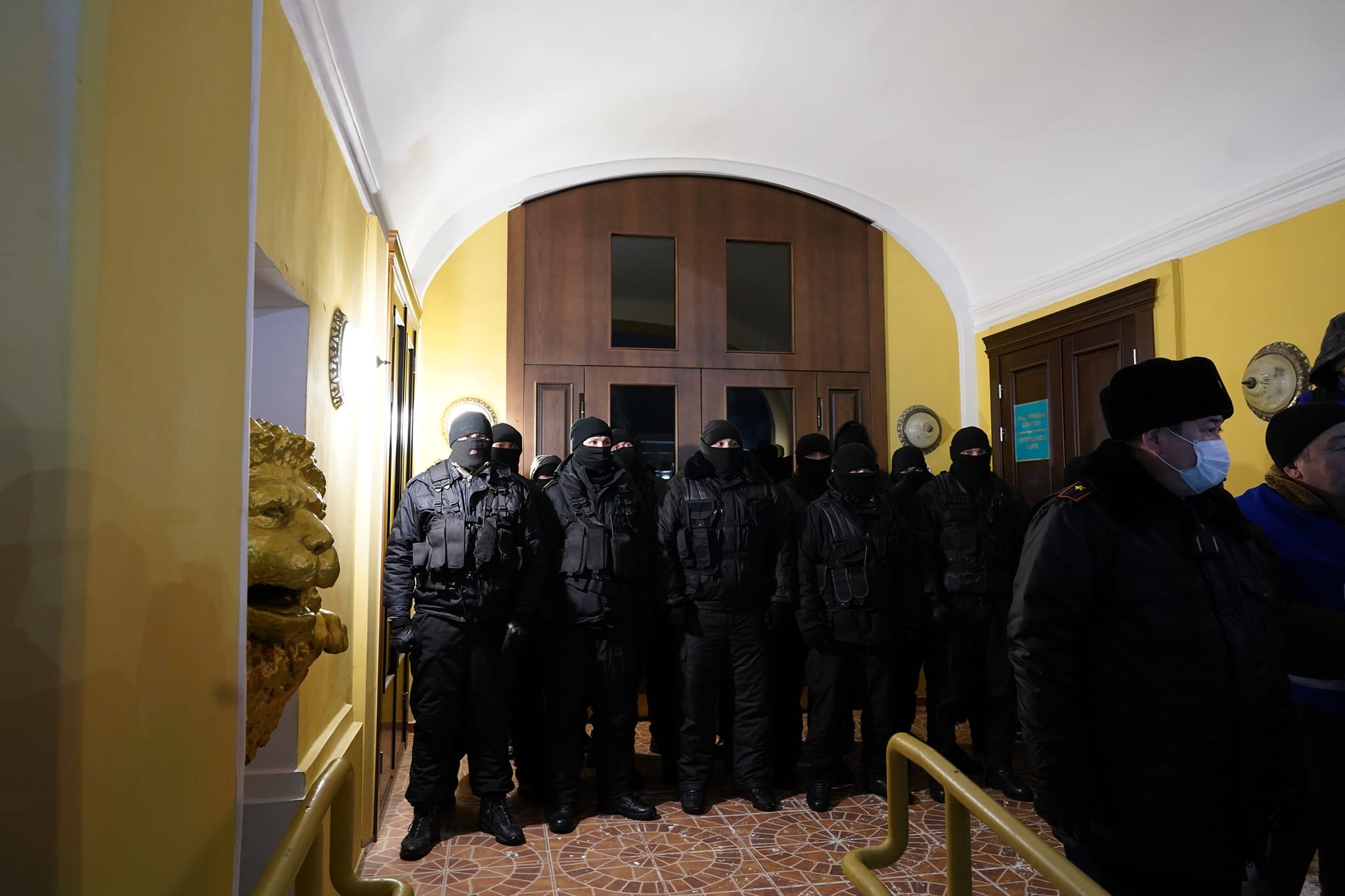
OMON guards (riot police) stand in the entrance to the regional mayor’s building. Photo credit: Raul Uporov.
Silence and Smoldering
On January 6, Uralsk was mostly quiet. While no one had died in the conflict with police in the city, several people were injured.
In Kyzylorda, where buildings and cars were still smoldering, an eerie silence descended on the city. Leaflets with Nazarbayev’s face lay tattered on the ground.
“It was as if these protesters had received some sort of stop signal,” Zhamilya said.
For several days there was no internet in the country. Zhamilya and a friend pooled their protest footage and posted the montage on January 18 to KyzylordaGo, the Instagram site Zhamilya manages. Yerkanat wrote an account about what had happened in Kyzylorda for Azattyq, RFE/RL’s Kazakh-language service, which was published January 21.
It would take days before Kyzylorda authorities assessed the damage: 24 government and business buildings were damaged; 718 people were detained by police; 210 people sought medical help; 33 were hospitalized.
More than the physical damage, dozens of people were killed, including a soldier. The true death count remains unknown. Yerkanat says he knows of 26 people who died; Zhamilya made a list of 25. Azattyq has reported information on 20 deaths. Of those, all were men, most under 30 years of age.
Yerkanat says little is known about most victims because law enforcement has ordered families to not provide information. Police questioned the injured in the hospital and summoned the relatives of the dead to the police department. Bodies have been exhumed by police and bullets retrieved, he reported.
Prosecuted
On January 7, at 7:30 a.m., the Uralsk police arrived at Lukpan’s house.
He was interrogated at the police station until 7 p.m. At 8 p.m., he appeared before a judge who sentenced him to 10 days in jail for participating in a protest. The video of him trying to calm the provocateurs was used to convict him.

Journalists Lukpan Akhmedyarov spent January 3 driving around town, looking for protesters. Photo provided by author.
“They didn’t care about me being a journalist,” Lukpan said. “They wanted to cut off all the heads of those involved in the uprising.”
For those 10 days, Lukpan said he either stared at the wall, or read books that he’d had the forethought to put in his car just in case he got arrested. He plowed through George Orwell’s “Animal Farm,” a book about Kazakhstan’s history called “Usurpers and Imposters of the Steppe Empire,” and Robert Sheckley’s “The Store of the Worlds.”
He also reflected on how he’d crossed a line as a journalist by taking up the bullhorn and trying to quiet the crowd.
“I’m familiar with the ethics of what I did,” he said. “I don’t regret anything. It was the right thing to do. I was trying to prevent anything bad from happening. It’s a feature of all these post-Soviet countries that journalists tend to become social activists or human rights activists.”
***
Tomorrow, January 5, we will follow the story of Kazakhstan’s Bloody January to Ust-Kamenogorsk to Kokshetau
Kazakhstan’s Bloody January: Day 3, Uralsk to Kyzylorda
Source: Frappler

0 Comments